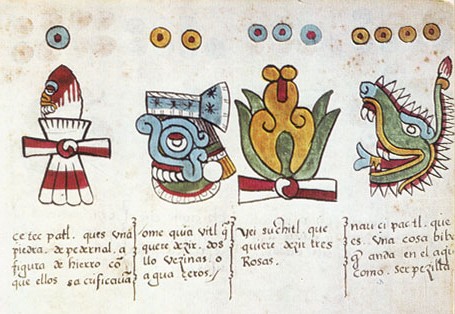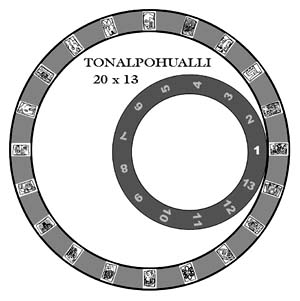Tōnalpōhualli on:
[Wikipedia]
[Google]
[Amazon]
 The (), meaning "count of days" in Nahuatl, is a Mexica version of the 260-day calendar in use in
The (), meaning "count of days" in Nahuatl, is a Mexica version of the 260-day calendar in use in
 The basis of the is unknown. Several theories have been advanced for this calendrical period: that it represents a
The basis of the is unknown. Several theories have been advanced for this calendrical period: that it represents a
File:Flower,Wind,Flint,Earthquake.jpg, Flower, Rain, Flint, Earthquake
File:Vulture,Eagle,Jaguar.jpg, Vulture, Eagle, Jaguar
File:Reed,Grass,Monkey,Dog.jpg, Reed, Grass, Monkey, Dog
File:Water,Rabbit,Deer.jpg, Water, Rabbit, Deer
File:Lizard,Snake,Death.jpg, Death, Snake, Lizard
File:House,Wind,Alligator.jpg, House, Wind, Alligator
Discussion of origin of the 260-day cycle
Animated tōnalpōhualli
{{Calendars , state=collapse Aztec calendars Specific calendars Obsolete calendars Nahuatl words and phrases
 The (), meaning "count of days" in Nahuatl, is a Mexica version of the 260-day calendar in use in
The (), meaning "count of days" in Nahuatl, is a Mexica version of the 260-day calendar in use in pre-Columbian
In the history of the Americas, the pre-Columbian era spans from the original settlement of North and South America in the Upper Paleolithic period through European colonization, which began with Christopher Columbus's voyage of 1492. Usually, ...
Mesoamerica
Mesoamerica is a historical region and cultural area in southern North America and most of Central America. It extends from approximately central Mexico through Belize, Guatemala, El Salvador, Honduras, Nicaragua, and northern Costa Rica ...
. This calendar is solar and consists of 20 13-day () periods. Each is ruled by a different deity. Graphic representations for the twenty day names have existed among certain ethnic, linguistic, or archaeologically identified peoples.
Description
 The basis of the is unknown. Several theories have been advanced for this calendrical period: that it represents a
The basis of the is unknown. Several theories have been advanced for this calendrical period: that it represents a Venus
Venus is the second planet from the Sun. It is sometimes called Earth's "sister" or "twin" planet as it is almost as large and has a similar composition. As an interior planet to Earth, Venus (like Mercury) appears in Earth's sky never f ...
ian cycle, that it represents the human gestation period, or that it represents the number of days between the zenithal passage of the sun in the tropical lowlands. On the other hand, some scholars including J. E. S. Thompson suggest that the was not based on natural phenomena at all, but rather on the integers 13 and 20, both considered important numbers in Mesoamerica.
The other major Mexica calendar, the , is a 365-day year, based on 18 months of 20 days and five nameless days. A was designated by the name of its first day. For example, met Moctezuma II on the day 8 Wind in the year 1 Reed (or November 8, 1519 in the Julian calendar
The Julian calendar, proposed by Roman consul Julius Caesar in 46 BC, was a reform of the Roman calendar. It took effect on , by edict. It was designed with the aid of Greek mathematicians and astronomers such as Sosigenes of Alexandr ...
).
The and the would coincide approximately every 52 years.
Day signs
Gallery of day signs
Note that the symbols are arranged counterclockwise around the calendar stone.See also
* Aztec calendar *Aztec calendar stone
The Aztec sun stone ( es, Piedra del Sol) is a late post-classic Mexica sculpture housed in the National Anthropology Museum in Mexico City, and is perhaps the most famous work of Mexica sculpture. It measures in diameter and thick, and weig ...
* Aztec mythology
* Maya calendar
The Maya calendar is a system of calendars used in pre-Columbian Mesoamerica and in many modern communities in the Guatemalan highlands, Veracruz, Oaxaca and Chiapas, Mexico.
The essentials of the Maya calendar are based upon a system which had ...
References
External links
Discussion of origin of the 260-day cycle
Animated tōnalpōhualli
{{Calendars , state=collapse Aztec calendars Specific calendars Obsolete calendars Nahuatl words and phrases